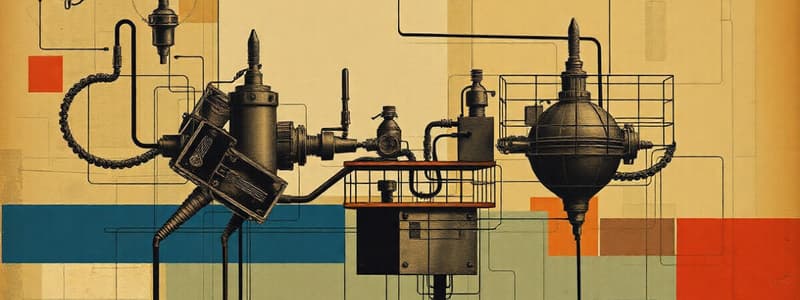Podcast
Questions and Answers
What is the primary function of the commutator in a DC machine?
What is the primary function of the commutator in a DC machine?
- To enhance the magnetic field strength
- To support the rotor during operation
- To ensure unidirectional current flow (correct)
- To convert mechanical energy into electrical energy
Which component of a DC generator is responsible for generating the magnetic field?
Which component of a DC generator is responsible for generating the magnetic field?
- Stator (correct)
- Commutator
- Rotor
- Bearings
What role do brushes play in a DC machine?
What role do brushes play in a DC machine?
- To reverse the magnetic field direction
- To induce EMF in the armature windings
- To support the mechanical structure of the machine
- To conduct current between stationary and rotating parts (correct)
According to Faraday's Law, what occurs when the armature of a DC generator spins in a magnetic field?
According to Faraday's Law, what occurs when the armature of a DC generator spins in a magnetic field?
What function do the yoke and pole shoes serve in a DC machine?
What function do the yoke and pole shoes serve in a DC machine?
What determines the direction of the induced EMF in a DC generator?
What determines the direction of the induced EMF in a DC generator?
How does a DC motor convert electrical energy into mechanical energy?
How does a DC motor convert electrical energy into mechanical energy?
Which part of a DC machine is typically a cylindrical laminated core?
Which part of a DC machine is typically a cylindrical laminated core?
What is the main purpose of brush shifting in electrical machines?
What is the main purpose of brush shifting in electrical machines?
Which method significantly improves commutation by neutralizing armature reaction?
Which method significantly improves commutation by neutralizing armature reaction?
What is a drawback of using compensating windings in electrical machines?
What is a drawback of using compensating windings in electrical machines?
What advantage do high-resistance brushes provide during commutation?
What advantage do high-resistance brushes provide during commutation?
Which characteristic is associated with the use of a split commutator?
Which characteristic is associated with the use of a split commutator?
Why is brush grade selection important in improving commutation?
Why is brush grade selection important in improving commutation?
Which of the following is a disadvantage of adjusting the Magnetic Neutral Axis (MNA)?
Which of the following is a disadvantage of adjusting the Magnetic Neutral Axis (MNA)?
What is a major limitation of brush shifting as a method to improve commutation?
What is a major limitation of brush shifting as a method to improve commutation?
In what scenario are high-resistance brushes especially beneficial?
In what scenario are high-resistance brushes especially beneficial?
What does the installation of compensating windings specifically target?
What does the installation of compensating windings specifically target?
What is a key advantage of single layer winding?
What is a key advantage of single layer winding?
Which type of winding is commonly used in larger machines?
Which type of winding is commonly used in larger machines?
What effect does armature reaction have on the main flux of a generator?
What effect does armature reaction have on the main flux of a generator?
What defines the magnetic neutral axis (M.N.A.)?
What defines the magnetic neutral axis (M.N.A.)?
What is one disadvantage of double layer winding?
What is one disadvantage of double layer winding?
What happens to the magnetic neutral axis during load conditions?
What happens to the magnetic neutral axis during load conditions?
What impact does the armature m.m.f. have on the main field?
What impact does the armature m.m.f. have on the main field?
How does the armature reaction lead to sparking at the brushes?
How does the armature reaction lead to sparking at the brushes?
Which rule helps determine the direction of armature current?
Which rule helps determine the direction of armature current?
What is the primary purpose of using double layer winding in machines?
What is the primary purpose of using double layer winding in machines?
What results from the armature being under the influence of the north pole?
What results from the armature being under the influence of the north pole?
What defines the leading pole tip in an armature?
What defines the leading pole tip in an armature?
How can the complexity of manufacturing affect winding choices?
How can the complexity of manufacturing affect winding choices?
What is the primary purpose of the armature windings in a DC motor?
What is the primary purpose of the armature windings in a DC motor?
Which factor does not influence the torque produced by a DC motor?
Which factor does not influence the torque produced by a DC motor?
What does Fleming's Left-Hand Rule help to determine in the context of a DC motor?
What does Fleming's Left-Hand Rule help to determine in the context of a DC motor?
How does wave winding differ in terms of parallel paths compared to lap winding?
How does wave winding differ in terms of parallel paths compared to lap winding?
Which equation correctly represents the EMF in a DC generator?
Which equation correctly represents the EMF in a DC generator?
In what scenario is lap winding preferred over wave winding?
In what scenario is lap winding preferred over wave winding?
What is the primary role of the commutator in a DC motor?
What is the primary role of the commutator in a DC motor?
Which of the following best describes the principle behind Lorentz force?
Which of the following best describes the principle behind Lorentz force?
What is the effect of increasing the number of armature conductors in a DC generator?
What is the effect of increasing the number of armature conductors in a DC generator?
Which of these is a disadvantage of lap winding?
Which of these is a disadvantage of lap winding?
In DC machines, which aspect determines the speed of the armature?
In DC machines, which aspect determines the speed of the armature?
What type of applications primarily utilize DC motors?
What type of applications primarily utilize DC motors?
How does the torque equation relate to the performance of a DC motor?
How does the torque equation relate to the performance of a DC motor?
Which statement about DC generators is incorrect?
Which statement about DC generators is incorrect?
What is one of the main advantages of wave winding over lap winding?
What is one of the main advantages of wave winding over lap winding?
What is the primary role of the demagnetising component OFd in the armature reaction?
What is the primary role of the demagnetising component OFd in the armature reaction?
What is indicated by the term 'commutation period' Tc?
What is indicated by the term 'commutation period' Tc?
How does current behave as coil B enters the short-circuit period?
How does current behave as coil B enters the short-circuit period?
What happens to the current in coil B after it completes its commutation period ideally?
What happens to the current in coil B after it completes its commutation period ideally?
What is a key factor that affects the ability to achieve ideal commutation?
What is a key factor that affects the ability to achieve ideal commutation?
What occurs if current reversal is not completed by the end of the commutation period?
What occurs if current reversal is not completed by the end of the commutation period?
During the short-circuit period, what current does coil B eventually carry?
During the short-circuit period, what current does coil B eventually carry?
What does a 'linear commutation' imply?
What does a 'linear commutation' imply?
Why do induced currents in armature conductors need to be rectified?
Why do induced currents in armature conductors need to be rectified?
What effect does an increase in armature current have on the distorting and demagnetising components?
What effect does an increase in armature current have on the distorting and demagnetising components?
What is a result of having coils in the magnetic neutral plane during commutation?
What is a result of having coils in the magnetic neutral plane during commutation?
What represents the difference in current between coils C and B during commutation?
What represents the difference in current between coils C and B during commutation?
What does the production of self-induced e.m.f. in the coil undergoing commutation cause?
What does the production of self-induced e.m.f. in the coil undergoing commutation cause?
What is depicted when the current change in coil B is represented by a horizontal line on a time base?
What is depicted when the current change in coil B is represented by a horizontal line on a time base?
Flashcards are hidden until you start studying
Study Notes
Armature Reaction
- Armature reaction refers to the magnetic field's effect caused by armature current on the main flux distribution in a generator.
- It mainly has two effects: Demagnetization and Cross magnetization.
- Demagnetization weakens the main flux, resulting in a reduced generated voltage.
- Cross magnetization distorts the main flux, leading to sparking at the brushes.
- Armature m.m.f. is represented by OFA.
- It can be resolved into two components: OFd (demagnetizing) and OFC (cross-magnetizing).
Commutation
- Commutation is the process where the current in the armature conductors reverses direction as they move from one pole to another.
- It occurs in the magnetic neutral axis (M.N.A.) or brush axis when the brush spans and short-circuits the coil.
- Ideal commutation happens when the current reversal completes by the end of the commutation period.
- Delay in current reversal due to self-induced e.m.f. in the coil leads to sparking between the brush and commutator.
- This self-induced e.m.f. is known as reactance voltage and is produced because of the coil's inductance.
- The current reversal is usually plotted on a time base to analyze it.
- Linear commutation happens if the current varies at a uniform rate.
- Spark occurs if the current in the coil does not completely reverse within the commutation period.
Commutation in Electrical Machines
- Commutation is the process of reversing the current flow in a coil of a DC machine when it passes under the brush.
- Short Circuit occurs when a coil is undergoing commutation and is directly connected to the brush, resulting in high current flow due to the low resistance of the coil.
- Self-induction causes an electromotive force (EMF) to induce a voltage in the coil during commutation.
- Spark occurs at the brush due to the induced voltage during commutation.
- Methods to improve commutation:
- Brush Shifting: adjusting the position of the brushes to align with the neutral axis to improve current reversal timing.
- Interpoles (Compoles): Small auxiliary poles between main poles that are connected in series with the armature to neutralize armature reaction.
- Compensating Windings: Windings placed in the main pole faces connected in series with the armature to oppose the armature reaction.
- High-Resistance Brushes: Increase brush resistance to reduce current density and smoothen commutation.
- Brush Grade Selection: Selecting right brush material (carbon, graphite, metal- graphite) based on the application.
- Magnetic Neutral Axis (MNA) Adjustment: Adjusting the MNA through field winding design and pole shoe shaping to improve commutation.
- Split Commutator: Dividing the commutator into smaller segments to achieve gradual commutation and reduce sparking.
Studying That Suits You
Use AI to generate personalized quizzes and flashcards to suit your learning preferences.





